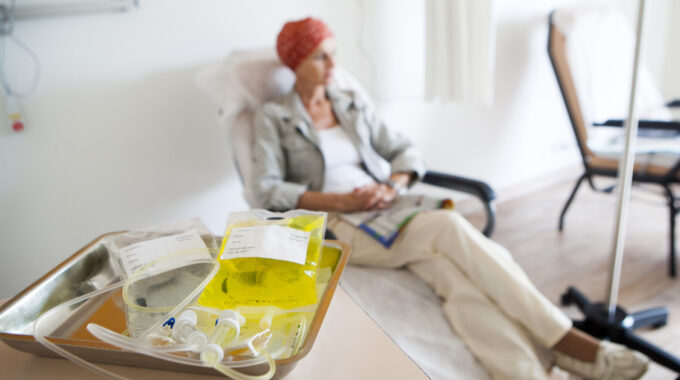
Half of Patients Seem to Misunderstand Palliative Treatments to Be Curative
In cancer care, chemotherapy can be delivered in an attempt to cure the cancer, or it can be administered only for symptom control. The latter is referred to as palliative chemotherapy. Effective symptom control at the end of life can extend life by weeks to months.1 However, oncologists have long noted the problem that many patients do not understand the very low likelihood of a cure from palliative chemotherapy. Alarmingly, studies suggest that 52% to 81% of patients seem to be under the false impression that palliative chemotherapy has more than a remote chance of curing their cancer.2 This common misunderstanding undermines the validity of informed consent for treatment and has been linked to burdensome treatments at the end of life. That’s why Andrea Enzinger, MD (Dana-Farber Cancer Institute) and colleagues recently tested teaching materials designed to improve patient information. The Journal of the American Medical Association published their results in July.
Can Uniform Teaching Materials Improve Patient Understanding of the Palliative Nature of Some Chemotherapy?
Dr. Enzinger and colleagues developed booklets and videos for five types of palliative chemotherapy and tested them at five oncology centers. The researchers described the teaching materials as “direct about the noncurative potential of palliative chemotherapy.” Patients were asked, “How likely do you think that chemotherapy is to cure your cancer?” The primary outcome of the trial was the percentage of patients who answer, “Not at all likely.”
Within three months, 78% of patients said they had read the booklets, and 40% said they had watched the videos. Unfortunately, they were no more likely to recognize the non-curative nature of palliative chemotherapy than patients receiving usual care. In the intervention group, 52.6% of patients gave the correct answer, while 55.5% of usual care patients gave the correct answer. The differences between the groups were not statistically significant.
Telling Patients There is No Cure Does Not Cause More Emotional Distress
Some have speculated that doctors play a role in this patient misunderstanding.4 Authors have noted that the misunderstanding results in higher medical spending.4 Less speculative is the fact that doctors have reported being hesitant to tell patients their prognosis for fear of a negative emotional reaction, sometimes termed as “depriving the patient of hope.”5
In the current study, this teaching material was not associated with greater distress. As a matter of fact, patient satisfaction in the educational material approached eight points on a ten-point scale. However, the no-increased-distress measurement may not be entirely helpful in that patients may have misunderstood the material. Moreover, a body of research shows that timely prognostic disclosure is connected with higher quality of life and better emotional outcomes for patient and family.5,6
Do Patients Misunderstand or Disbelieve?
Researchers note that their study was not designed to differentiate between misunderstanding the information versus simply choosing not to believe the information. A more accurate primary question may have been “Did the information provided say the chemotherapy is very likely, somewhat likely, or not likely at all to cure the cancer?” Then follow that with a question about what the patient believes. Nevertheless, Dr. Enzinger and colleagues state an intent to try again. Their current plan is to try booklets that are more brief and supplement that information with nurse-led teaching.
References
- Oostendorp LJ, Stalmeier PF, Donders AR, van der Graaf WT, Ottevanger PB. Efficacy and safety of palliative chemotherapy for patients with advanced breast cancer pretreated with anthracyclines and taxanes: a systematic review. Lancet Oncol. 2011;12(11):1053–61.
- El-Jawahri A, Traeger L, Park ER, Greer JA, Pirl WF, Lennes IT, Jackson VA, Gallagher ER, Temel JS. Associations among prognostic understanding, quality of life, and mood in patients with advanced cancer. Cancer. 2014;120(2):278–85.
- Enzinger AC, Uno H, McCleary N, Frank E, Sanoff H, Van Loon K, Matin K, Bullock A, Cronin C, Cibotti H, Bagley J. Effectiveness of a Multimedia Educational Intervention to Improve Understanding of the Risks and Benefits of Palliative Chemotherapy in Patients With Advanced Cancer: A Randomized Clinical Trial. JAMA Oncology. 2020.
- Oostendorp LJ, Ottevanger PB, Donders AR, van de Wouw AJ, Schoenaker IJ, Smilde TJ, van der Graaf WT, Stalmeier PF. Decision aids for second-line palliative chemotherapy: a randomised phase II multicentre trial. BMC Medical Informatics and Decision Making. 2017 Dec 1;17(1):130.
- Wright A, Zhang B, Ray A, et al. Associations between end-of-life discussions, patient mental health, medical care near death, and caregiver bereavement adjustment. JAMA. 2008; 300 (14): 1665-73.
- Enzinger, Andrea C., et al. Outcomes of prognostic disclosure: Associations with prognostic understanding, distress, and relationship with physician among patients with advanced cancer. Journal of Clinical Oncology. 2015; 33 (32): 3809-3816.





